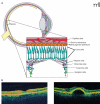Age-related macular degeneration: genetic and environmental factors of disease
- PMID: 21045241
- PMCID: PMC3002218
- DOI: 10.1124/mi.10.5.4
Age-related macular degeneration: genetic and environmental factors of disease
Abstract
Age-related macular degeneration (AMD) is the most common cause of visual impairment among the elderly in developed countries, and its prevalence is thus increasing as the population ages; however, treatment options remain limited because the etiology and pathogenesis of AMD are incompletely defined. Recently, much progress has been made in gene discovery and mechanistic studies, which clearly indicate that AMD involves the interaction of multiple genetic and environmental factors. The identification of genes that have a substantial impact on the risk for AMD is not only facilitating the diagnosis and screening of populations at risk but is also elucidating key molecular pathways of pathogenesis. Pharmacogenetic studies of treatment responsiveness among patients with the "wet" form of AMD are increasingly proving to be clinically relevant; pharmacogenetic approaches hold great promise for both identifying patients with the best chance for vision recovery as well as tailoring individualized therapies.
Figures




References
-
- Penfold PL, Killingsworth MC, Sarks SH. (1985) Senile macular degeneration: the involvement of immunocompetent cells. Graefes Arch Clin Exp Ophthalmol 223:69–76 - PubMed
-
- Klein R, Klein BE, Linton KL. (1992) Prevalence of age-related maculopathy. The Beaver Dam eye study. Ophthalmology 99:933–943 - PubMed
-
- Vingerling JR, Dielemans I, Hofman A, Grobbee DE, Hijmering M, Kramer CF, de Jong PT. (1995) The prevalence of age-related maculopathy in the Rotterdam Study. Ophthalmology 102:205–210 - PubMed
-
- Hageman GS, Luthert PJ, Victor Chong NH, Johnson LV, Anderson DH, Mullins RF. (2001) An integrated hypothesis that considers drusen as biomarkers of immune-mediated processes at the RPE-Bruch’s membrane interface in aging and age-related macular degeneration. Prog Retin Eye Res 20:705–732 - PubMed
-
- Kaplan HJ, Leibole MA, Tezel T, Ferguson TA. (1999) Fas ligand (CD95 ligand) controls angiogenesis beneath the retina. Nat Med 5:292–297 - PubMed
Publication types
MeSH terms
Grants and funding
LinkOut - more resources
Full Text Sources
Other Literature Sources
Medical
